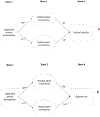More Than Just Keeping Busy: The Protective Effects of Organized Activity Participation on Violence and Substance Use Among Urban Youth
- PMID: 29948859
- PMCID: PMC6172482
- DOI: 10.1007/s10964-018-0868-8
More Than Just Keeping Busy: The Protective Effects of Organized Activity Participation on Violence and Substance Use Among Urban Youth
Abstract
Violence and substance use disproportionately affect African American youth in urban, disadvantaged communities. Expanding positive peer and adult connections is a mechanism by which organized activity participation may reduce risk of negative outcomes. We assessed if organized activity participation decreases the likelihood of later negative outcomes through expanding positive social connections using a parallel mediation model (Wave 1: N = 681; 50% female; Mage = 14.86 years; SD = 0.65). We found indirect effects from participation to cigarette use (b = -0.04, 95% CI: -0.07, -0.01) and violent behavior (b = -0.04; 95% CI: -0.07, -0.01) through positive peer connections. We did not find indirect effects through positive adult connections. This may be because of the notable influence of peers on negative outcomes during adolescence. Organized activities can help youth expand positive peer connections, which, in turn, reduces risk of later negative outcomes. Implications for prevention are discussed.
Keywords: Adolescent; Adolescent development; African Americans; Extracurricular activities; Peer group; Peer influence; Tobacco use; Youth alcohol consumption; Youth violence.
Conflict of interest statement
Conflicts of Interest
The authors report no conflict of interests.
Figures
Similar articles
-
Trajectories of Organized Activity Participation Among Urban Adolescents: An Analysis of Predisposing Factors.J Youth Adolesc. 2016 Jan;45(1):225-38. doi: 10.1007/s10964-015-0267-3. Epub 2015 Mar 4. J Youth Adolesc. 2016. PMID: 25735866 Free PMC article.
-
Trajectories of Organized Activity Participation Among Urban Adolescents: Associations with Young Adult Outcomes.J Community Psychol. 2017 May;45(4):513-527. doi: 10.1002/jcop.21863. Epub 2017 Jan 31. J Community Psychol. 2017. PMID: 28579654 Free PMC article.
-
Organized Activity Involvement among Urban Youth: Understanding Family- and Neighborhood- Level Characteristics as Predictors of Involvement.J Youth Adolesc. 2018 Aug;47(8):1697-1711. doi: 10.1007/s10964-018-0823-8. Epub 2018 Feb 22. J Youth Adolesc. 2018. PMID: 29470760
-
Protective factors within the family, and their role in fostering resiliency in African American adolescents.J Cult Divers. 1997 Winter;4(4):110-7. J Cult Divers. 1997. PMID: 9555376 Review.
-
How Do Contextual Factors Influence Implementation and Receipt of Positive Youth Development Programs Addressing Substance Use and Violence? A Qualitative Meta-Synthesis of Process Evaluations.Am J Health Promot. 2018 May;32(4):1110-1121. doi: 10.1177/0890117116670302. Epub 2016 Oct 21. Am J Health Promot. 2018. PMID: 29667497
Cited by
-
Parental Perceived Discrimination and Youth Participation in Out-Of-School Sports.Children (Basel). 2022 Nov 24;9(12):1808. doi: 10.3390/children9121808. Children (Basel). 2022. PMID: 36553252 Free PMC article.
-
Positive Parenting Moderates the Effect of Socioeconomic Status on Executive Functioning: A Three-Generation Approach.J Child Fam Stud. 2019 Jul;28(7):1878-1885. doi: 10.1007/s10826-019-01411-x. Epub 2019 Apr 20. J Child Fam Stud. 2019. PMID: 31656391 Free PMC article.
-
Impact of a Nyakaza Move-for-Health Intervention Programme among Adolescents in a Resource-Constrained South African Community.Int J Environ Res Public Health. 2024 May 31;21(6):717. doi: 10.3390/ijerph21060717. Int J Environ Res Public Health. 2024. PMID: 38928962 Free PMC article.
-
Retaliatory attitudes as mediator of exposure to violence and firearm aggression among youth: The protective role of organized activity involvement.Dev Psychol. 2022 May;58(5):990-1002. doi: 10.1037/dev0001339. Epub 2022 Apr 4. Dev Psychol. 2022. PMID: 35377700 Free PMC article.
-
Adolescent Life Satisfaction: Association with Psychological, School-Related, Religious and Socially Supportive Factors.Children (Basel). 2023 Jul 7;10(7):1176. doi: 10.3390/children10071176. Children (Basel). 2023. PMID: 37508673 Free PMC article.
References
-
- Benson P, Mannes M, Pittman K, & Ferber T (2004). Youth Development, Developmental Assets, and Public Policy In Lerner R & Steinberg L (Eds.), Handbook of Adolescent Psychology: Second Edition (2nd ed., pp. 781–814). Hoboken, NJ: Wiley & Sons; 10.1002/9780471726746.ch25 - DOI
-
- Bohnert A, Fredricks J, & Randall E (2010). Capturing Unique Dimensions of Youth Organized Activity Involvement: Theoretical and Methodological Considerations. Review of Educational Research, 80(4), 576–610. 10.3102/0034654310364533 - DOI
MeSH terms
Grants and funding
LinkOut - more resources
Full Text Sources
Other Literature Sources
Medical


